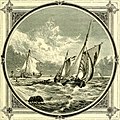
A Dutch barge [1] is a traditional flat-bottomed shoal-draught barge, originally used to carry cargo in the shallow Zuiderzee and the waterways of The Netherlands. [2] There are many types of Dutch barge, with characteristics determined by regional conditions and traditions.
Contents
- The Dutch barge
- Dutch barge types
- The EU's Recreational Craft Directive
- See also
- Further reading
- References
Originally, Dutch barges were sailing craft with wooden hulls. Today, while few wooden examples remain, there are many steel barges that are 100 years old or more. Although most Dutch barges have been converted to motor-propulsion, schuyt sailing contests are still held on the IJsselmeer and on the Wadden Sea (Waddenzee). Dutch barges have become popular live-aboard leisure craft, and brand-new "Dutch-style" examples continue to be built.






